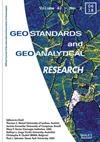First Principles Calibration of 40Ar Abundances in 40Ar/39Ar Mineral Neutron Fluence Monitors: Methodology and Preliminary Results
IF 2.7
2区 地球科学
Q2 GEOCHEMISTRY & GEOPHYSICS
引用次数: 0
Abstract
The accuracy and traceability of geochronometers are of vital importance to questions asked by many Earth scientists. The widely applied 40Ar/39Ar geochronometer relies on the co‐irradiation of samples with neutron fluence monitors (reference materials) of known ages; the ages and uncertainties of these monitors are critical to our ability to apply this chronometer. Previously, first principles, astronomical and optimisation calibrations have been made. The first principles method for determining the age of monitor minerals is the K‐Ar method, which involves measurement of their 40K and 40Ar* abundances. The AQuA (Absolute Quantities of Argon) pipette system, which emits calibrated quantities of 40Ar* via the ideal gas law, was used to calibrate the sensitivity of the system across a range of source pressures and estimate 40Ar* abundances in neutron fluence monitors. These 40Ar abundances were combined with existing 40K abundance data for these monitors. Ages for HD‐B1 and MD2 (GA1550) biotite fluence monitors were calculated and combined with intercalibration data for HD‐B1 and Fish Canyon sanidine (FCs) to determine ages for FCs. Current results do not have the targeted accuracy when compared with previous calibrations; however, we show how the extensive methodology development presented here can be used towards making reliable future measurements.

40Ar/39Ar矿物中子通量监测器中40Ar丰度的第一原理校准:方法和初步结果
地质年代计的准确性和可追溯性对许多地球科学家提出的问题至关重要。广泛应用的40Ar/39Ar地质年代计依赖于样品与已知年龄的中子注量监测器(参考材料)的共同辐照;这些显示器的年龄和不确定性对我们应用这种计时器的能力至关重要。以前,已经进行了第一原理、天文和优化校准。确定监测矿物年龄的第一原理方法是K-Ar法,该方法涉及测量其40K和40Ar*丰度。AQuA(氩气绝对量)移液管系统通过理想气体定律发射校准量的40Ar*,用于校准系统在一系列源压力下的灵敏度,并估计中子注量监测器中的40Ar丰度。这些40Ar丰度与这些监测器现有的40K丰度数据相结合。计算HD-B1和MD2(GA1550)黑云母注量监测器的年龄,并将其与HD-B1与Fish Canyon sanidine(FCs)的相互校准数据相结合,以确定FCs的年龄。与以前的校准相比,当前的结果不具有目标精度;然而,我们展示了如何利用这里提出的广泛的方法发展来进行可靠的未来测量。
本文章由计算机程序翻译,如有差异,请以英文原文为准。
求助全文
约1分钟内获得全文
求助全文
来源期刊

Geostandards and Geoanalytical Research
地学-地球科学综合
CiteScore
7.10
自引率
18.40%
发文量
54
审稿时长
>12 weeks
期刊介绍:
Geostandards & Geoanalytical Research is an international journal dedicated to advancing the science of reference materials, analytical techniques and data quality relevant to the chemical analysis of geological and environmental samples. Papers are accepted for publication following peer review.
 求助内容:
求助内容: 应助结果提醒方式:
应助结果提醒方式:


